It’s been 16 days since I’ve seen a Prairie Falcon along the causeway and I had just about given up on them for the short-term. But yesterday, as I was leaving the island after a relatively fruitless morning, I spotted that distinctive flash of bright breast whites up ahead among the rocks and very close to the road. Sure enough, as I got closer I could tell it was Falco mexicanus perched on a colorful boulder.
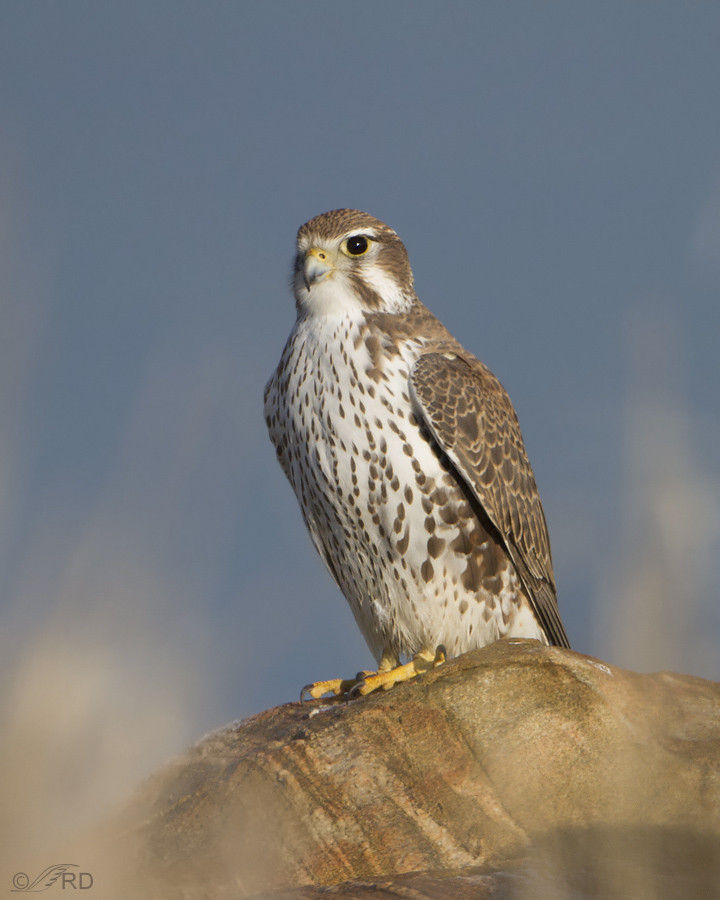
1/3200, f/6.3, ISO 640, 500 f/4, 1.4 tc, natural light, not baited, set up or called in, background is the Great Salt Lake
I’ll sheepishly admit to the fact that in situations like this I typically come down with a case of “buck fever” (aggravated by the fact that I have familial tremors) and sure enough I was actually shaking with excitement and dread as I tried to maneuver my pickup to get a clear shot of the bird through all the vegetation along the road. With this particular perch, this was the most unobstructed view I could get. In case you’re wondering what the source of my “dread” could be, I’m a dedicated pessimist at heart (which Mia mercilessly teases me about) and I’m always convinced that the bird will take off a split second before I get the pickup stopped in a safe place and my finger on the shutter. That exact thing had happened twice that morning with Red-tailed Hawks.
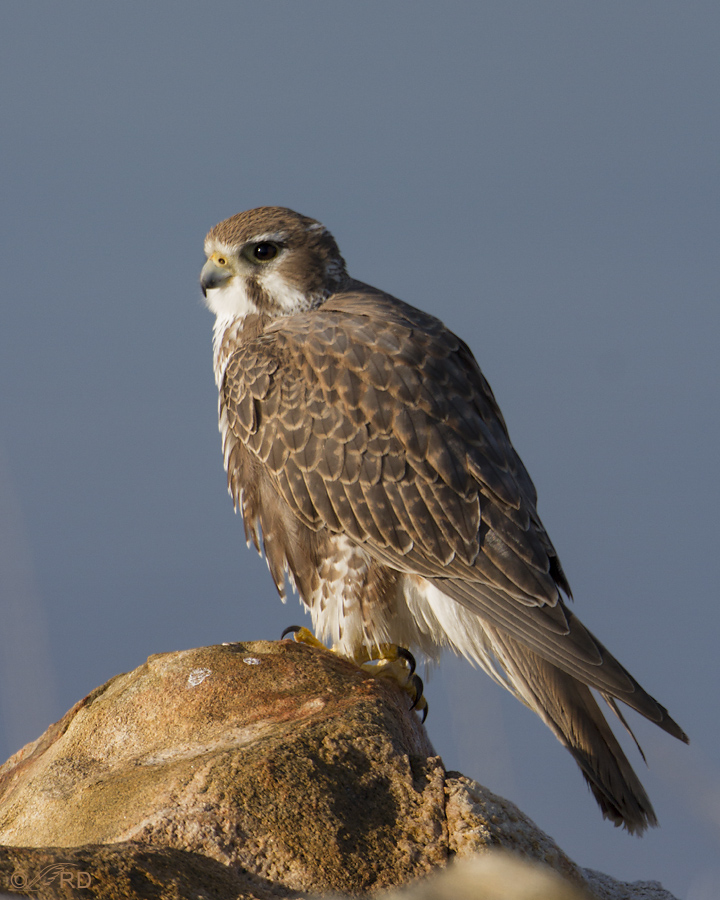
1/1600, f/6.3, ISO 500, 500 f/4, 1.4 tc, natural light, not baited, set up or called in, background is the Great Salt Lake
I believe this bird was actively hunting ducks and it would perch for a few minutes, then fly up or down the causeway buzzing waterfowl and then land on another rock. I could never see where it had landed so I had to search for it again each time. This was the third rock I found the falcon on (the second one had a crappy background and light angle).
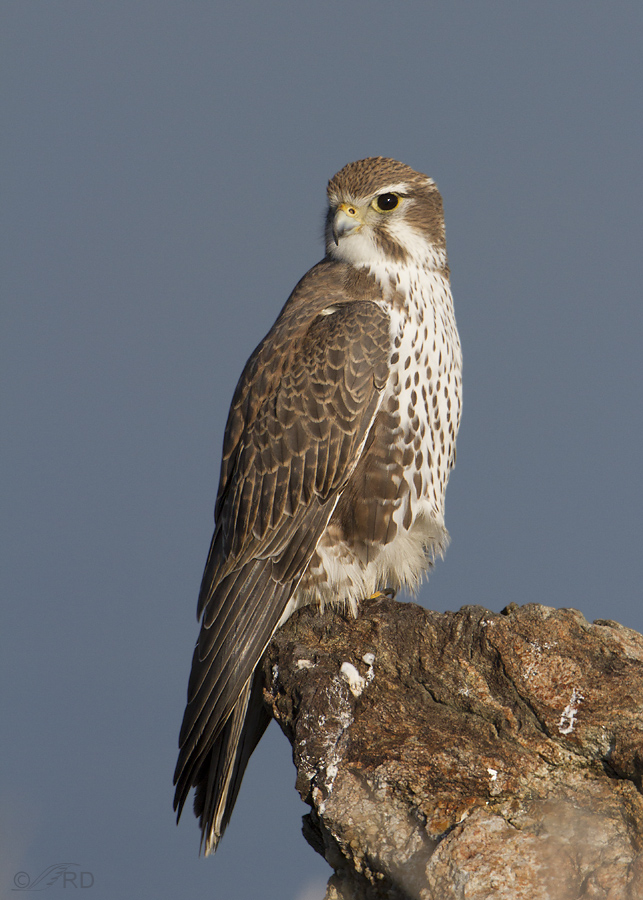
1/2500, f/8, ISO 500, 500 f/4, 1.4 tc, natural light, not baited, set up or called in, background is the Great Salt Lake
This was my favorite perch of the morning for this bird. I had an unobstructed view of the falcon, the sun was almost directly behind me and I liked the rock and the background. The falcon rested here for almost 10 minutes – what more could I ask for?
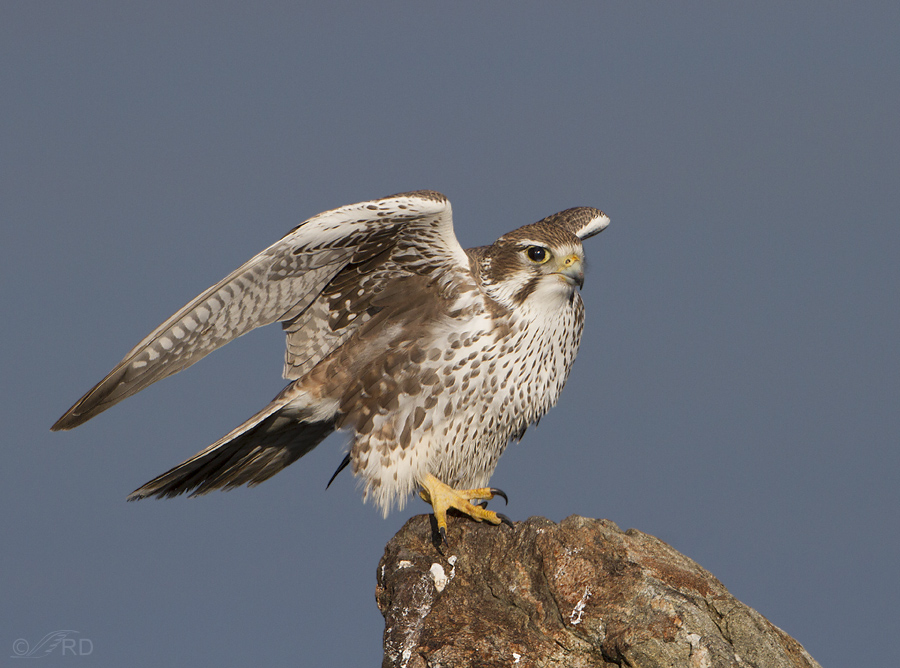
1/3200, f/8, ISO 500, 500 f/4, natural light, not baited, set up or called in, background is the Great Salt Lake
When the falcon decided it was time to go hunting again, it raised its wings just before take-off. Thankfully, in preparation for just that, I had already removed my tc so I wouldn’t clip anything.
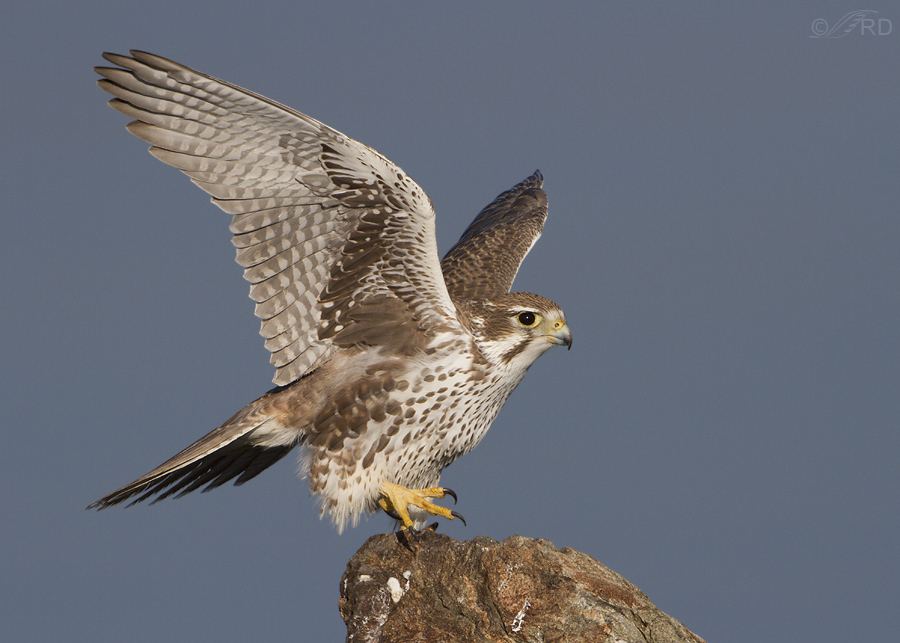
1/3200, f/8, ISO 500, 500 f/4, natural light, not baited, set up or called in, background is the Great Salt Lake
As it raised them even higher I got my favorite shot of the morning, with a nice wing position, a raised foot and good eye contact.
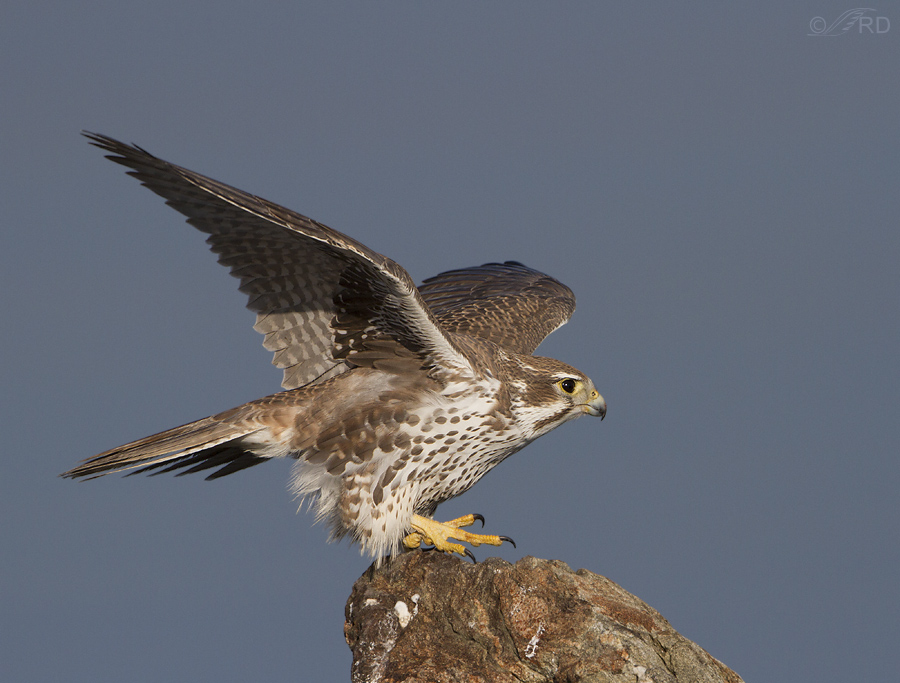
1/3200, f/8, ISO 500, 500 f/4, natural light, not baited, set up or called in, background is the Great Salt Lake
And then the falcon took off. I deleted the actual lift-off shots because the bird had turned away from me and I clipped the wings anyway.
I’m hoping to get some feedback from any raptor specialists or falconers who may read this regarding a couple of questions I have. I believe I’m beginning to see a pattern when Prairie Falcons take off. Quite often they seem to raise their wings up like this and hold them there for a second or two before they actually lift off. That’s a pattern I haven’t noticed in other falcons (I have limited experience with Peregrines) or raptors so I’m wondering if it might be a behavioral trait largely exclusive to Prairie Falcons.
And I strongly suspect this to be the same bird as in my recent post of just over two weeks ago of a Prairie Falcon with a duck kill. Can anyone tell for sure?
Thanks for any help.
Ron


These are magnificent shots,as usual….”Familial tremor”??? You’ve got to be kidding…with all your shots so crystal clear and as sharp as broken glass??? You must have the best IS made.
It’s not pessimism if it happens often enough! Like this morning along Wasatch Blvd. when a pure chocolate Red-tail waited until the very last second of set up to crush my hopes of a decent picture. Ah well, better to have it in the memory card between one’s ears than not at all. I looked at both of your sweet Prairie posts for a long time trying to figure out if they were the same bird. Without figuring it out. Go figure. But I’d wager they are. Raptors are creatures of habit, especially when successfully finding prey on a regular basis. Falcons not as much as Buteos, but still… two very similar adult female Prairies in the same general area in the same general time frame are worth betting a beer on!
Aren’t incidents like that frustrating, Mike! I guess the way I look at it is that I’d rather be pleasantly surprised than unpleasantly surprised, so I always go into the situation expecting the worst. Just my nature…
And I wouldn’t bet against you – I also suspect they’re most likely the same bird. Thanks for weighing in on the question.
Oh how I have missed the magic you bring to my screen. And yes, the shakes are a source of frustration aren’t they. And I love that your pessimistic fear is so often wrong leaving you with wonderful images like these to delight us. Thank you. Yet again.
Thank you, Elephants Child. And welcome back. I’ve missed you!
Absolutely stunning. My initial inclination was similar to Reid’s, might as well throw away my camera! However, I prefer to think that there is still hope! You definitely had no buck fever to worry about! Most of the raptors I encounter use an elevated perch and simply “launch” rather than having to make a concerted effort to gain altitude immediately. I’ll definitely be on the lookout for take-off patterns.
This was a really nice post and my hands actually started shaking as I looked at your wonderful images!
Wally, There is always “hope” and I do a lot of it. Keep in mind that it took me over two weeks to locate this bird again. And, as an old retired coot, I have the luxury of being able to spend a lot of time in the field – a distinct disadvantage over those unable to do so. Thank you for your very nice comment.
Ron,
Wonderful images of a very beautiful bird (as always). Regarding the wing lift prior to takeoff: I see Prairie Falcons quite regularly in the Klamath Basin and they do not show that behavior. On the other hand (there is ALWAYS the other hand), the birds I see are almost always perched on the crossbars of utility poles. When they take off, they usually dive down, and occasionally fly straight out (with a slight downward component), but rarely (never?) fly up. They seem to tuck their wings, dive, and then enter flapping flight. In fact, when preparing a field trip group for Prairie Falcon encounters, I tell them to be aware that the bird will most likely fly down; that way, folks have a better chance of keeping their bins on it.
Combining my experiences with yours, I wonder if the takeoff behavior is a function of the perch elevation. Now I’ll be on the lookout for birds on lower perches!
It’s very interesting to me that you have noticed this, because I regularly comment on Prairie Falcons’ takeoffs. BTW, regarding your “shakes”, they must go away once you hit the shutter – your pics look like the work of someone with brain-surgeon steadiness…
Eureka, I think you’re likely right, Dick! Never thought of that. I’ve seen them take off from high poles too (mostly in Montana) and never noticed them doing the wing thing before lift-off in that situation. And looking back, when I have seen the wing lift, they’ve been on the ground or a very low perch. Perhaps it’s some sort of preparatory thing before an upwards take-off.
One of the things I try to be very aware of when photographing birds at take-off is just what you mention – predicting angle of take-off, based on elevation of perch, size and weight of the bird, inclination of the species, etc. Very important when trying to get the entire bird in the frame without clipping anything with a long lens.
Big thanks for your insight – very interesting. And helpful!
And by the way – my apparent “brain surgeon steadiness” is largely due to the magic of image stabilization in modern lenses. Without it, I likely wouldn’t be photographing birds…
You da man. I love seeing your blogs in my email daily!
I’m absolutely delighted to hear that you’re enjoying the posts, Mitchell.
SO BEAUTIFUL!!!! Wonderful photos of a stunning creature!
Thanks very much, Nicole.
Beautiful little duck killer! I know, I know, but they are so perfectly built for it! Thank you!
Yes, Tana and that “perfect build” for the job at hand is incredibly evident when you see them in action. So damned impressive!
Just stunning. What a brilliant specimen, and as always perfect captures…
Christina, I learned today from Mark Runnels that this bird is a female and I agree – she is a striking specimen.
Mark and Louise, Thank you very much for the correction on the scientific name. I’ve made the correction in my text. It was a silly mistake and one I know better than to make…
Hello Ron,
These are wonderful pictures Ron. Because of seeing these wonderful pictures I am going to have to remove myself from your email list and stop photography because there is no chance I can ever be as good or as lucky as you and others. I will give up photography forever. I am a loser at this game of life.
Reid, I sure hope you’re kidding about the “loser” part but I thank you for the compliment.
Gorgeous shots, as usual, Ron. Your posts have become a highlight of my day. But, just in case anyone files by Latin name – this is a Falco mexicanus; Falco sparverius is the American kestrel. I can’t comment on the take off, as we don’t get a lot of Prairies on this side of the Cascades. But it would be interesting to get some really slow motion shots of different birds taking off – how much is push off from the legs, how much downdraft from the wings.
Louise, I’ve made the change on the latin name. Thank you. Your slo-mo idea sounds like an interesting one. To me, it seems like they use their legs more when they have to take off upwards from a low perch or the ground. Elevated perches, not so much.
Hi Ron,
They are both mature female Prairie Falcons (Falco Mexicanus), beyond that it is hard to tell. Unlike Red Tails and even Peregrines, Prairies have very little color variation so it can be difficult to tell them apart. The second bird has a bruise on the top of her cere. These are fairly common, and can persist for months. I was hoping that this would be a clue, but the first bird does not have the same bruise. It may be a different bird, or it may have have been bruised in the time between the two shoots. Other than that, I don’t see any identifying marks on either bird.
With regards to the wing position prior to take off, this is very comon behavior in Peregrines and Gyrs. I haven’t noticed whether Kestrels and smaller falcons do the same thing. Now I am going to have to watch them and see!
Beautiful shots. Thanks for sharing.
Mark
I appreciate your help in trying to answer both questions, Mark. I’ve seen kestrels do the same thing (wing position prior to take-off) but only a couple of times in the thousands of take-offs I’ve observed. It seems much more common in Prairie Falcons. I’ve never noticed it with Merlins but then I haven’t spent a lot of time with that species either.
Ron, I can so relate. I don’t know how many times I shook with anticipation as I tried to maneuver my vehicle into position. Sometimes I am lucky, other times not so. A couple of weeks ago my nemesis bird, the Northern Harrier, landed on the ground about 25 yards in front of my car. Before I moved up, I carefully made sure my camera was steady on the window, then started to creep around to the right for a good shot out my left side. I was about to get the bird in focus, when it took off. So I wait and watch for another attempt……
Aww, that’s really too bad, Bob. I know just how much you want that harrier shot…
Lovely shots, and it’s a treat to see that animal so clearly. A friend of mine worked (years ago) for a v. famous wildlife/nature photographer, and if that guy missed an important shot, he’d throw up. =) I think I prefer your stress symptom to his.
Me too, biobabbler. Me too!
I wish in my life to take these great images.
That’s quite a compliment, Senglim. Thank you.
So beautiful! Thanks for sharing these.
Thanks for appreciating them, Sharon.